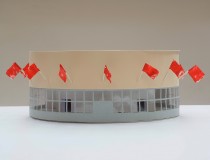alexandra paperno
SUSPENSE
2014–2015
“God is the ‘infinitely distant man’”.
– Edmund Husserl The Crisis of European Sciences and Transcendental Phenomenology
Alexandra sees interiors as deserted as the ones captured by the camera of Alfred Hitchock, freezing time in endless and anxious expectation – suspense. When portraying the interiors presented in her three-picture frame series, Alexandra shifts the perspective, creating the effect of vertigo. In the films of the mid-1950s, Hitchcock diverged from Hollywood’s gold standard, which prescribed combining the perspective of the camera with that of the director and viewer, and instead transmitted to the camera the perspective of the actor who is feeling dizzy. Paperno presents us with such a perspective for examination, which changes our gravitational settings: she does not represent, but instead places us inside these almost flat images.
COLOURIZATION
2015
Eleven red flags are installed on flagpoles located around the entire perimeter of the facade of the Circular Kinopanorama. A red flag appears on the mast of the battleship at the end of Sergei Eisenstein’s film Battleship Potemkin. To make the flag appear red on the ship’s mast in the black-and-white silent film, the editors had to colour in a large number of the film frames. The red flags on the facade of the Circular Kinopanorama have also been coloured manually in an expressive manner. The 11 repetitions of the flag’s colouring create a sensation of moving film frames. The eleven flag frames accord the old cinema a similarity to the celebrated battleship in the film, no longer sailing through the lines of enemy ships as in in Eisenstein’s film, but instead through time.
Alexandra Paperno was born in Moscow in 1978. At the age of 13 she moved with her parents to USA. In 2000 she graduated from The Cooper Union for the Advancement of Science and Art (New York) where she studied under Dore Ashton (Art Theory and History), Gian Berto Vanni (Colour Theory and Painting Techniques), Robert Breer (Film) and Hans Haacke (3D Design and Installation). Her first solo exhibition took place at the National Centre for Contemporary Art, Moscow in 2004. Since then she has held numerous solo exhibitions at both Russian and international museums (the Moscow Museum of Modern Art; the Schusev State Museum of Architecture; Museo Lapidarium, Novigrad, etc.) and galleries (Stella Art Foundation; GMG; Paperworks, Moscow, etc.). Paperno’s works have also been displayed at the Moscow Biennale of Contemporary Art, the Moscow International Forum of Art Initiatives, the Prague Biennale and Venice Biennale. She lives and works in Moscow.
![Alexandra Paperno. “Suspense” 2014. Acrylic and rice paper on canvas. 120 x 160 cm [Александра Паперно] [Alexandra Paperno]](https://cinemaofrepeatfilm.ru/wp-content/uploads/2016/02/6small-210x160.jpg)
![Alexandra Paperno. “Suspense” 2015. Acrylic and rice paper on canvas. 120 x 160 cm [Александра Паперно] [Alexandra Paperno]](https://cinemaofrepeatfilm.ru/wp-content/uploads/2016/02/5small-210x160.jpg)
![Alexandra Paperno. “Suspense” 2015. Acrylic and rice paper on canvas. 120 x 160 cm [Александра Паперно] [Alexandra Paperno]](https://cinemaofrepeatfilm.ru/wp-content/uploads/2016/02/4small-210x160.jpg)
![Exhibition View at ССС Smena. Photo Denis Volkov [Александра Паперно] [Alexandra Paperno]](https://cinemaofrepeatfilm.ru/wp-content/uploads/2016/02/IMG_8761-210x160.jpg)
![Exhibition View at the Circular Kinopanorama. Photo: Yuri Palmin [Александра Паперно] [Alexandra Paperno]](https://cinemaofrepeatfilm.ru/wp-content/uploads/2016/02/12010501_1083622624990188_3681532239346659435_o-210x160.jpg)
![Exhibition View at the Circular Kinopanorama. Photo: Yuri Palmin [Александра Паперно] [Alexandra Paperno]](https://cinemaofrepeatfilm.ru/wp-content/uploads/2016/02/DSC8373-1-210x160.jpg)
![Exhibition View at the Circular Kinopanorama. Photo: Yuri Palmin [Александра Паперно] [Alexandra Paperno]](https://cinemaofrepeatfilm.ru/wp-content/uploads/2016/02/DSC8374-210x160.jpg)
![Alexandra Paperno. “Colorization” 2015 [Александра Паперно] [Alexandra Paperno]](https://cinemaofrepeatfilm.ru/wp-content/uploads/2016/02/Panorama_01-210x160.jpg)

![Alexandra Paperno. “Colorization” 2015 [Александра Паперно] [Alexandra Paperno]](https://cinemaofrepeatfilm.ru/wp-content/uploads/2016/02/Paperno_001-210x160.jpg)
![Alexandra Paperno. “Colorization” installation view at the facade of the Circular Kinopanorama Pavilion, 2015. Installation View [Александра Паперно] [Alexandra Paperno]](https://cinemaofrepeatfilm.ru/wp-content/uploads/2016/02/73-210x160.jpg)
![Exhibition View at ССС Smena. Photo Denis Volkov [Александра Паперно] [Alexandra Paperno]](https://cinemaofrepeatfilm.ru/wp-content/uploads/2016/02/IMG_8928-210x160.jpg)